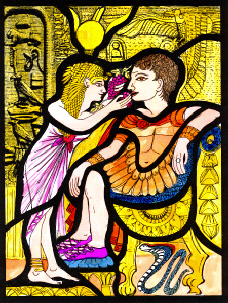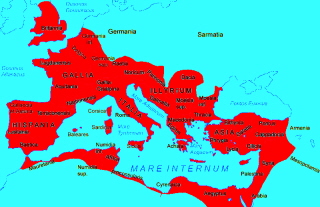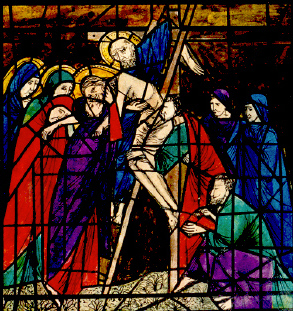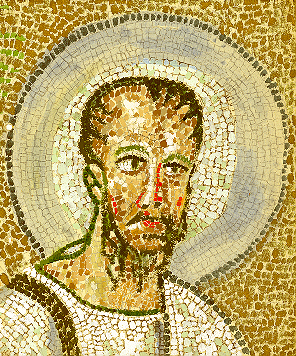The Roman Empire. 44 B.C.
The Formation of The Roman Empire.
 After the Assassination of Julius Ceasar in 44 B.c. The Republic was faced with internal political struggles. Marcus Antonius, commonly known as Mark Antony had been appointed consul to Caesar and headed the legions giving him immense popul;arity and power within the republic.Caesar named his grand-nephew the youthful Octavian as his successor. They combined their forces with Marcus Aemilius Lepidus and ruled the republic together as a triumvirate. It was never a confortable or fully operational alliance, resulting in Octavian dividing the Republic into three. Octavian taking Italy and the Western provinces, Lepidus being given Africa, and Mark Antony being given the East that included Egypt (and providing history with one of the great tragic love stories of all time!) After the deaths of Cleopatra and Antony, Octavian regained control of the Republic, declaring himself in 29 B.C. Emperor Augustus, undisputed ruler of the entire Roman Empire.
After the Assassination of Julius Ceasar in 44 B.c. The Republic was faced with internal political struggles. Marcus Antonius, commonly known as Mark Antony had been appointed consul to Caesar and headed the legions giving him immense popul;arity and power within the republic.Caesar named his grand-nephew the youthful Octavian as his successor. They combined their forces with Marcus Aemilius Lepidus and ruled the republic together as a triumvirate. It was never a confortable or fully operational alliance, resulting in Octavian dividing the Republic into three. Octavian taking Italy and the Western provinces, Lepidus being given Africa, and Mark Antony being given the East that included Egypt (and providing history with one of the great tragic love stories of all time!) After the deaths of Cleopatra and Antony, Octavian regained control of the Republic, declaring himself in 29 B.C. Emperor Augustus, undisputed ruler of the entire Roman Empire.
The Roman Empire (as it is with all Empires and Colonial power) was achieved through military might, dividing and conquering all who dared to oppose it. The spoils of war and newly gained territories contributed to make Rome a very rich city.
 In order to maintain this level of wealth, power and population growth, the Roman Republic had to expand it's military might and conquer all the surrounding countries and lands in the mediterranean. But the Empire, could not contain its growing appetite for wealth and resources. Having quelled most neighbouring tribes, and countries, the quest for much needed resources now involved travelling further afield, conquering the Franks,
the Allemani, the Suevi, the Saxons, and then the Barbarian tribes, the Ajans, the Huns, the Rugians, the Jutes, the Angles, the Celts
and my ancestors - the Picts, the Scoti , the Brigante and other tribes of Britain who were used as recruits, slaves or as cheap labor in all aspects of Roman life and industry.
The Roman way of life "civilized" Europe. Many Romans stayed behind in these countries and (as it was in my family's case) married locals who new acquired skills and professions. The Romans introduced taxation into Great Britain, and an imported bureaurocracy of scribes and collectors.
One such Roman taxcollector (a patrician) had a son - Patrick, that chased the snakes (heathen practices), out of Ireland and introduced Christianity into Ireland and Britain. The Romans having removed most of Britain's timber and other valuable resources could not maintain their Empirical Power in Northern Britain . They built a wall across Northern England (Hadrian's Wall which later became the Scottish Border) to keep the Picts, Scoti, Celts and other tribes at bay.
However, the Roman Manpower was over-extended and they retreated back to Rome. Everywhere they had conquered, they left a legacy of new advanced ways of living and magnificent examples of their Greco-Roman architecture, engineering, crafts, and civilization.
In order to maintain this level of wealth, power and population growth, the Roman Republic had to expand it's military might and conquer all the surrounding countries and lands in the mediterranean. But the Empire, could not contain its growing appetite for wealth and resources. Having quelled most neighbouring tribes, and countries, the quest for much needed resources now involved travelling further afield, conquering the Franks,
the Allemani, the Suevi, the Saxons, and then the Barbarian tribes, the Ajans, the Huns, the Rugians, the Jutes, the Angles, the Celts
and my ancestors - the Picts, the Scoti , the Brigante and other tribes of Britain who were used as recruits, slaves or as cheap labor in all aspects of Roman life and industry.
The Roman way of life "civilized" Europe. Many Romans stayed behind in these countries and (as it was in my family's case) married locals who new acquired skills and professions. The Romans introduced taxation into Great Britain, and an imported bureaurocracy of scribes and collectors.
One such Roman taxcollector (a patrician) had a son - Patrick, that chased the snakes (heathen practices), out of Ireland and introduced Christianity into Ireland and Britain. The Romans having removed most of Britain's timber and other valuable resources could not maintain their Empirical Power in Northern Britain . They built a wall across Northern England (Hadrian's Wall which later became the Scottish Border) to keep the Picts, Scoti, Celts and other tribes at bay.
However, the Roman Manpower was over-extended and they retreated back to Rome. Everywhere they had conquered, they left a legacy of new advanced ways of living and magnificent examples of their Greco-Roman architecture, engineering, crafts, and civilization.
The end of Roman Empire and the influx of non-Italians absorbed into Italy.
Again the face of the Italian population changed as slaves (that escaped death by persecution, over-work, or worse yet, being fed to the lions), traders, merchants, religious leaders, teachers, craftmen and warriors thronged into Italy from all corners of the Roman Empire.
 The multi-ethnic religious practices of the citizens of Rome were tolerated as long as the Empire's authority and loyalty was maintained. While Rome ruled Palestine, Jesus of Nazareth was singled out by the powerful Jewish leaders and Pontius Pilate the Roman official, as a rebel capable of disturbing the Roman rule and challenging Hebrew laws. After Jesus was executed, many supporters resented this and other extreme Roman measures and rose up against the foreign rulers. Rome sent an army to destroy Jerusalem. By 70 A.D. the Jewish state that had existed from ancient times was abolished.
The multi-ethnic religious practices of the citizens of Rome were tolerated as long as the Empire's authority and loyalty was maintained. While Rome ruled Palestine, Jesus of Nazareth was singled out by the powerful Jewish leaders and Pontius Pilate the Roman official, as a rebel capable of disturbing the Roman rule and challenging Hebrew laws. After Jesus was executed, many supporters resented this and other extreme Roman measures and rose up against the foreign rulers. Rome sent an army to destroy Jerusalem. By 70 A.D. the Jewish state that had existed from ancient times was abolished.
The Jews were enslaved and dispersed throughout the empire, many of them preserved their culture and religious practises.
The teachings of Jesus rooted in the ancient Hebrew texts and religion, were spread by, the desciples as apostles. Peter the apostle travelled to Rome where he converted Jews and Romans to Christianity.

Paul, before his conversion to Christ was known as Saul, a Greek-speaking Jew from Tarsus in Asia- minor, although not one of the original apostles, He carried the Christian teachings to the vast Eastern Roman Empire.
As a result of his travels Christian ideals were spread to Jews and Gentiles far and wide. Paul's letters to these new communities formed the basis of the scriptures in the New Testament.
The Roman government did not take kindly to the new values and teachings of the Christian converts, seeing them as an afront to their authority.
Christians became the target of persecution, and often as scapegoats and distraction during times of poor economical and political conditions.
Both Peter and Paul perished as a result of Nero's persecution policies.
This only served to fuel martyrdom and strengthen the Christian faith.
When the Roman Empire was divided, the authority of Rome was in decline Diocletian who was made General in the East of the empire retired due to illness, as a result of a long power struggle Constantine emerged victorious in 312 A.D.
Constantine - The new Roman Emperor from the East.
 Constantine who recognised Christianity, reunited the two empires and built a new capital at Byzantium. This new Roman capital became known as Constantinople a 'Christian' city, not pagan, emphasizing the declining power of the City of Rome and the rise to power of the Eastern Provinces of the Roman Empire. The Eastern Roman Empire under Constantine flourished due to securing the borders and expanding commerce in the Eastern Mediterranenan providing much needed riches. But in the Western Roman Empire strict laws and rules devized by Diocletian and introduced and enforced by Constantine created much discontent, resulting in political and economic decay. After Constantine's death in 337 A.D. the Eastern Empire still flourished but the Western Empire collapsed and could not be defended.
Weakened by Civil wars and strife the Western Romans could not defend their territories against the Germans who were multiplying and advancing as a military force on the Roman frontiers. The Huns advanced into German Ostragoth territory from Asia and easily defeated them. The Visigoths, a German (Christian) tribe on the Roman Border, first saught protection from the Romans, then turned on them, but defeated the Huns. The Romans held the Huns at bay, Attila the leader withdrew, on his death the Hun Empire collapsed. The Vandals (from Germany) gained Spain and North Africa as a peace offering to stem the tide of attacks. The Empire was in a state of collapse, attacked on all fronts resulting in many of Roman Cities being sacked. All the other former enemies that had been conquered by the Romans grew more powerful and regained much of their former kingdoms.
Constantine who recognised Christianity, reunited the two empires and built a new capital at Byzantium. This new Roman capital became known as Constantinople a 'Christian' city, not pagan, emphasizing the declining power of the City of Rome and the rise to power of the Eastern Provinces of the Roman Empire. The Eastern Roman Empire under Constantine flourished due to securing the borders and expanding commerce in the Eastern Mediterranenan providing much needed riches. But in the Western Roman Empire strict laws and rules devized by Diocletian and introduced and enforced by Constantine created much discontent, resulting in political and economic decay. After Constantine's death in 337 A.D. the Eastern Empire still flourished but the Western Empire collapsed and could not be defended.
Weakened by Civil wars and strife the Western Romans could not defend their territories against the Germans who were multiplying and advancing as a military force on the Roman frontiers. The Huns advanced into German Ostragoth territory from Asia and easily defeated them. The Visigoths, a German (Christian) tribe on the Roman Border, first saught protection from the Romans, then turned on them, but defeated the Huns. The Romans held the Huns at bay, Attila the leader withdrew, on his death the Hun Empire collapsed. The Vandals (from Germany) gained Spain and North Africa as a peace offering to stem the tide of attacks. The Empire was in a state of collapse, attacked on all fronts resulting in many of Roman Cities being sacked. All the other former enemies that had been conquered by the Romans grew more powerful and regained much of their former kingdoms.
Meanwhile Christianity had spread to the farthest ends of the Roman Empire.
Constantine had declared the new religion to be officially tolerated with the Edict of Milan in 313. A.D., and in 395 A.D. Christianity was proclaimed the official religion of the Roman Empire.
The last western Roman Emperor, Romulus Augustulus was overthrown by Odoacer (435-493?) who was proclaimed King of Italy. The Roman Empire then became - The Holy Roman Empire
Ref:Gibbons: Decline and Fall of the Roman Empire.
More on the Romans for kids at:http://cybersleuth-kids.com/sleuth/History/Ancient_Civilizations/Rome/index.htm
 After the Assassination of Julius Ceasar in 44 B.c. The Republic was faced with internal political struggles. Marcus Antonius, commonly known as Mark Antony had been appointed consul to Caesar and headed the legions giving him immense popul;arity and power within the republic.Caesar named his grand-nephew the youthful Octavian as his successor. They combined their forces with Marcus Aemilius Lepidus and ruled the republic together as a triumvirate. It was never a confortable or fully operational alliance, resulting in Octavian dividing the Republic into three. Octavian taking Italy and the Western provinces, Lepidus being given Africa, and Mark Antony being given the East that included Egypt (and providing history with one of the great tragic love stories of all time!) After the deaths of Cleopatra and Antony, Octavian regained control of the Republic, declaring himself in 29 B.C. Emperor Augustus, undisputed ruler of the entire Roman Empire.
After the Assassination of Julius Ceasar in 44 B.c. The Republic was faced with internal political struggles. Marcus Antonius, commonly known as Mark Antony had been appointed consul to Caesar and headed the legions giving him immense popul;arity and power within the republic.Caesar named his grand-nephew the youthful Octavian as his successor. They combined their forces with Marcus Aemilius Lepidus and ruled the republic together as a triumvirate. It was never a confortable or fully operational alliance, resulting in Octavian dividing the Republic into three. Octavian taking Italy and the Western provinces, Lepidus being given Africa, and Mark Antony being given the East that included Egypt (and providing history with one of the great tragic love stories of all time!) After the deaths of Cleopatra and Antony, Octavian regained control of the Republic, declaring himself in 29 B.C. Emperor Augustus, undisputed ruler of the entire Roman Empire. In order to maintain this level of wealth, power and population growth, the Roman Republic had to expand it's military might and conquer all the surrounding countries and lands in the mediterranean. But the Empire, could not contain its growing appetite for wealth and resources. Having quelled most neighbouring tribes, and countries, the quest for much needed resources now involved travelling further afield, conquering the Franks,
the Allemani, the Suevi, the Saxons, and then the Barbarian tribes, the Ajans, the Huns, the Rugians, the Jutes, the Angles, the Celts
and my ancestors - the Picts, the Scoti , the Brigante and other tribes of Britain who were used as recruits, slaves or as cheap labor in all aspects of Roman life and industry.
The Roman way of life "civilized" Europe. Many Romans stayed behind in these countries and (as it was in my family's case) married locals who new acquired skills and professions. The Romans introduced taxation into Great Britain, and an imported bureaurocracy of scribes and collectors.
One such Roman taxcollector (a patrician) had a son - Patrick, that chased the snakes (heathen practices), out of Ireland and introduced Christianity into Ireland and Britain. The Romans having removed most of Britain's timber and other valuable resources could not maintain their Empirical Power in Northern Britain . They built a wall across Northern England (Hadrian's Wall which later became the Scottish Border) to keep the Picts, Scoti, Celts and other tribes at bay.
However, the Roman Manpower was over-extended and they retreated back to Rome. Everywhere they had conquered, they left a legacy of new advanced ways of living and magnificent examples of their Greco-Roman architecture, engineering, crafts, and civilization.
In order to maintain this level of wealth, power and population growth, the Roman Republic had to expand it's military might and conquer all the surrounding countries and lands in the mediterranean. But the Empire, could not contain its growing appetite for wealth and resources. Having quelled most neighbouring tribes, and countries, the quest for much needed resources now involved travelling further afield, conquering the Franks,
the Allemani, the Suevi, the Saxons, and then the Barbarian tribes, the Ajans, the Huns, the Rugians, the Jutes, the Angles, the Celts
and my ancestors - the Picts, the Scoti , the Brigante and other tribes of Britain who were used as recruits, slaves or as cheap labor in all aspects of Roman life and industry.
The Roman way of life "civilized" Europe. Many Romans stayed behind in these countries and (as it was in my family's case) married locals who new acquired skills and professions. The Romans introduced taxation into Great Britain, and an imported bureaurocracy of scribes and collectors.
One such Roman taxcollector (a patrician) had a son - Patrick, that chased the snakes (heathen practices), out of Ireland and introduced Christianity into Ireland and Britain. The Romans having removed most of Britain's timber and other valuable resources could not maintain their Empirical Power in Northern Britain . They built a wall across Northern England (Hadrian's Wall which later became the Scottish Border) to keep the Picts, Scoti, Celts and other tribes at bay.
However, the Roman Manpower was over-extended and they retreated back to Rome. Everywhere they had conquered, they left a legacy of new advanced ways of living and magnificent examples of their Greco-Roman architecture, engineering, crafts, and civilization.
 The multi-ethnic religious practices of the citizens of Rome were tolerated as long as the Empire's authority and loyalty was maintained. While Rome ruled Palestine, Jesus of Nazareth was singled out by the powerful Jewish leaders and Pontius Pilate the Roman official, as a rebel capable of disturbing the Roman rule and challenging Hebrew laws. After Jesus was executed, many supporters resented this and other extreme Roman measures and rose up against the foreign rulers. Rome sent an army to destroy Jerusalem. By 70 A.D. the Jewish state that had existed from ancient times was abolished.
The multi-ethnic religious practices of the citizens of Rome were tolerated as long as the Empire's authority and loyalty was maintained. While Rome ruled Palestine, Jesus of Nazareth was singled out by the powerful Jewish leaders and Pontius Pilate the Roman official, as a rebel capable of disturbing the Roman rule and challenging Hebrew laws. After Jesus was executed, many supporters resented this and other extreme Roman measures and rose up against the foreign rulers. Rome sent an army to destroy Jerusalem. By 70 A.D. the Jewish state that had existed from ancient times was abolished. 
 Constantine who recognised Christianity, reunited the two empires and built a new capital at Byzantium. This new Roman capital became known as Constantinople a 'Christian' city, not pagan, emphasizing the declining power of the City of Rome and the rise to power of the Eastern Provinces of the Roman Empire. The Eastern Roman Empire under Constantine flourished due to securing the borders and expanding commerce in the Eastern Mediterranenan providing much needed riches. But in the Western Roman Empire strict laws and rules devized by Diocletian and introduced and enforced by Constantine created much discontent, resulting in political and economic decay. After Constantine's death in 337 A.D. the Eastern Empire still flourished but the Western Empire collapsed and could not be defended.
Weakened by Civil wars and strife the Western Romans could not defend their territories against the Germans who were multiplying and advancing as a military force on the Roman frontiers. The Huns advanced into German Ostragoth territory from Asia and easily defeated them. The Visigoths, a German (Christian) tribe on the Roman Border, first saught protection from the Romans, then turned on them, but defeated the Huns. The Romans held the Huns at bay, Attila the leader withdrew, on his death the Hun Empire collapsed. The Vandals (from Germany) gained Spain and North Africa as a peace offering to stem the tide of attacks. The Empire was in a state of collapse, attacked on all fronts resulting in many of Roman Cities being sacked. All the other former enemies that had been conquered by the Romans grew more powerful and regained much of their former kingdoms.
Constantine who recognised Christianity, reunited the two empires and built a new capital at Byzantium. This new Roman capital became known as Constantinople a 'Christian' city, not pagan, emphasizing the declining power of the City of Rome and the rise to power of the Eastern Provinces of the Roman Empire. The Eastern Roman Empire under Constantine flourished due to securing the borders and expanding commerce in the Eastern Mediterranenan providing much needed riches. But in the Western Roman Empire strict laws and rules devized by Diocletian and introduced and enforced by Constantine created much discontent, resulting in political and economic decay. After Constantine's death in 337 A.D. the Eastern Empire still flourished but the Western Empire collapsed and could not be defended.
Weakened by Civil wars and strife the Western Romans could not defend their territories against the Germans who were multiplying and advancing as a military force on the Roman frontiers. The Huns advanced into German Ostragoth territory from Asia and easily defeated them. The Visigoths, a German (Christian) tribe on the Roman Border, first saught protection from the Romans, then turned on them, but defeated the Huns. The Romans held the Huns at bay, Attila the leader withdrew, on his death the Hun Empire collapsed. The Vandals (from Germany) gained Spain and North Africa as a peace offering to stem the tide of attacks. The Empire was in a state of collapse, attacked on all fronts resulting in many of Roman Cities being sacked. All the other former enemies that had been conquered by the Romans grew more powerful and regained much of their former kingdoms.